Chemical and Process Engineering Resources

Rupture Disks for Process Engineers - Part 4
Nov 08 2010 01:30 PM | pleckner in Safety and Pressure ReliefBackpressure
A rupture disk is actually a differential pressure device where the specified burst pressure is equal to the difference between the desired upstream pressure (vessel) at the time of rupture disk burst and the downstream pressure (backpressure):
Pburst = Pvessel - Pbackpressure
Or alternately the desired upstream pressure (vessel) at the time of rupture disk burst is equal to the sum of the specified burst pressure and the downstream pressure (backpressure):
Pvessel = Pburst + Pbackpressure
Either way, it is apparent that the vessel pressure at the time the rupture disk bursts (commonly called the relief pressure) is directly dependent on backpressure.
When discussing relief systems, three types of backpressure are considered, these being constant, built-up and superimposed.
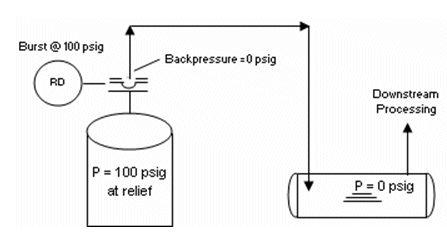 |
| Figure 1A: Single Vessel, Single Rupture Disk Protection, Expected Constant Back pressure = 0 psig |
Figure 1A shows a system comprised of a single vessel protected by a single rupture disk with a specified burst pressure of 100 psig. The relief pipe discharges a few inches below the liquid surface in a knockout drum, which is held at a constant 0-psig pressure. Therefore, the rupture disk sees a constant (fixed) backpressure of 0 psig. If the vessel were to go into relief, this disk will burst at 100 psig and the vessel relief pressure will be 100 psig (100 + 0 = 100).
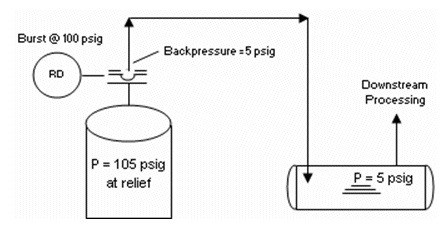 |
| Figure 1B: Single Vessel, Single Rupture Disk Protection, Actual Constant Back pressure >Â Expected |
Figure 1B is the same system however for some reason the pressure in the knockout drum is to be maintained at 5 psig instead of 0 psig. The constant (fixed) backpressure against the rupture disk is now 5 psig. If the vessel were to go into relief, the rupture disk would still burst at 100 psig but the vessel relief pressure would now be 105 psig (100 + 5 = 105) rather than the 100 psig expected. This situation could result in a violation of code3.
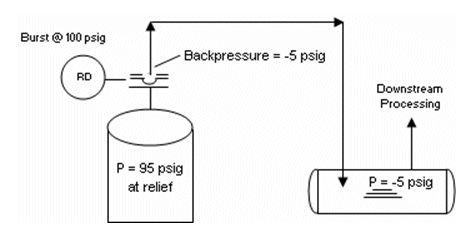 |
| Figure 1C: Single Vessel, Single Rupture Disk Protection, Actual Constant Back pressure <Â Expected |
Figure 1C is again the system however for some reason the pressure in the knockout drum is to be maintained at -5 psig instead of 0 psig. The constant (fixed) backpressure against the rupture disk is now -5 psig. If the vessel were to go into relief, the rupture disk would still burst at 100 psig but the vessel relief pressure would now be only 95 psig (100 + (- 5) = 95) rather than the 100 psig expected. There is no particular safety concern here because the vessel can't over pressure. However, the Operating Ratio is affected, which can result in a very premature bursting of the rupture disk.
For the vessel relief pressure to be specified correctly, the rupture disk vendor must be told the constant back pressure so that the rupture disk can be designed accordingly. And, if you truly want the vessel relief pressure to be at a specific value then the "constant" backpressure given to the vendor must be maintained at all times.
The key point is that during design, be aware of the constant backpressure and ensure that the vessel relief pressure will not violate code or affect normal operation.
Â
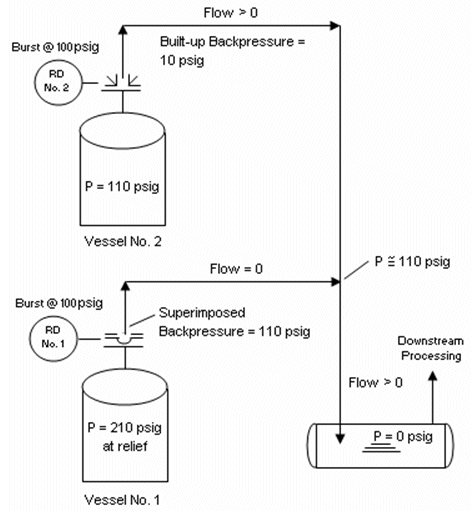 |
Figure 2A: Two Vessel System - Common Discharge |
Now let's look at the system shown in Figure 2A. A second vessel with a single rupture disk also specified to burst at 100 psig is added in close proximity to the first vessel. The relief piping from the two vessels is tied into a common header before discharging into a knockout drum in the same manner as before, the tie-in occurs near the vessels. At the exact moment Vessel No. 2 goes into relief and its rupture disk bursts, Vessel No. 2's relief pressure is 100 psig due to the constant 0-psig backpressure as described above. After the disk bursts, flow is established causing pressure to build up in the piping system (built-up backpressure). The amount of built-up backpressure is dependent on the system pressure drop and possibly even the phenomenon of choked flow. For the purpose of this discussion, assume total built-up backpressure is 10 psig after rupture disk No. 2 bursts and the pressure in Vessel No. 2 is about 110 psig. Because of the proximity of the two discharge pipes and vessels, the pressure near vessel No. 1 will also be at about 110 psig. This pressure, which is exerted or imposed onto rupture disk No. 1, is called the superimposed backpressure with respect to rupture disk No. 1. If vessel No. 1 were to go into relief shortly afterwards, then for rupture disk No. 1 to burst, the pressure in vessel No. 1 would have to build to about 210 psig (100 + 110)!  This is clearly unacceptable!!
One solution to this potentially catastrophic condition is to separate the two relief lines so that one cannot directly affect the other (see Figure 2B below). Of course the answer may very well be that this is not an application for rupture disks but for relief valves! The key point is, avoid combining multiple rupture disk piping into a common relief header.
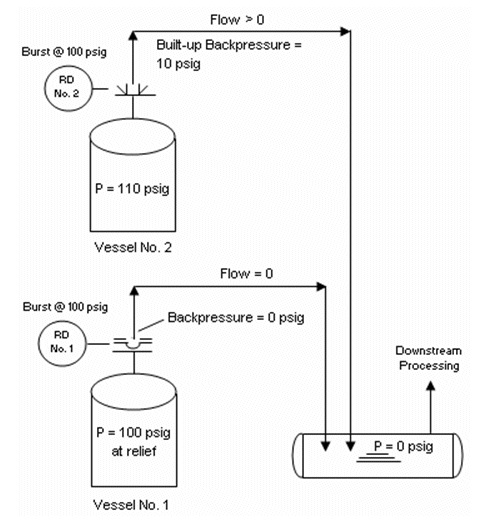 |
| Figure 2B: Two Vessel System - Common Discharge Built-up and Superimposed Back Pressures |
Note that built-up backpressure is variable and depends on the relieving rate, which is a function of the relieving scenario. Also, built-up backpressure has no affect on the vessel's relief pressure for systems such as those shown in Figure 1 above. Built-up backpressure is the result of fluid flow only and there is no fluid flow before the rupture disk bursts.
Therefore, along with the Manufacturing Range (MR), Operating Ratio (OR) and Burst Tolerance (BT) that were discussed in Part 3, the process design engineer must also strongly consider the backpressure (especially superimposed backpressure) when specifying the rupture disk.
Â

 FB
FB

0 Comments